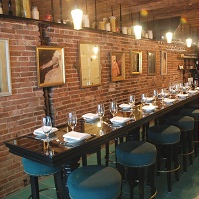Socarrat

Photo: Cititour.com
Contact Info:
Address: 259 W 19th St (7th & 8th Aves)
City: New York, NY
Zip: 10011
map: View the Map
Phone: (212) 462-1000
Website: http://socarratpaellabar.com/
Food Info:
Menu: View the Menu
Cuisine:
Spanish
Cititour Review:
Rice, an ancient grain rich with history, has roots in every country, and every culture. Korea has its Bibimbap, Italy its risotto, and India its biryani. In my Persian family, rice, what we call polo, is also a main ingredient in our daily life. Whether cooked with dill and fava beans, or steamed with raisins, carrots, braised veal and saffron, it’s not only the centerpiece of every meal, it is really the culinary soul of our family. It is probably the first solid food I ate as a toddler, and if I were asked to name my last meal on earth, a plate of Bibi’s rice could be its one and only course.If you’ve ever had Persian rice you also know that often the best part is the crust or tadig. In my family, we layer the bottom of the pot with thinly sliced potatoes drizzled with vegetable oil which results in a giant golden potato crust, or we mix a little rice with egg which forms a sort of Frisbee sized rice-as-crepe on the bottom. Either way, whatever gets banged out of the bottom of the rice pot is a prized possession at the dinner table. Many wars have been waged between those seated around the table over that caramelized bottom dweller.
In Spain, where Paella is their country’s rice dish, a crust also forms, this one on the bottom of the wide shallow pans brimming with rice, shellfish, and chicken. The crispy rice is called the socarrat, and I imagine similar crust battles unfolding in homes from Valencia to Barcelona, where socarrat is fervently scraped up from the bottom of the pan until there’s little need for a dishwasher.
Now comes Socarrat Paella Bar, the second restaurant venture from the charming and gracious Lolo Manso, who also owns La Nacional at the Spanish Benevolent Society, an under-the-radar expat hangout on West 14th Street. This is a man who knows his way around a paella pan, and here in his slim, low-lit exposed brick restaurant the size of a cell-phone shop, he and his chef Felipe Camarillo (Suba and Marichu) are serving the best I have had in this city—rice so perfectly cooked that each grain of rice is chewy but distinct and endowed with so much flavor that just a single grain on a plate would (almost) be enough. His paella would indeed qualify as the best I’ve ever had, but that is not possible as I have had paella in Spain, with my toes in the sand, dining at a restaurant on the Mediterranean in Castelldefels after my friend Vern’s wedding in Barce. In any case, the paella at Socarrat is exquisite, and worth a trip, and the potential wait for one of the 24 coveted seats at the long, lean high-top communal table. But before you get to the paella, you will need to have a few tapas. So grab a friend (it’s easiest to eat with just one person at the communal table), a bottle of wine (they are BYOB for now), and get ready to feast.
Diana and I started looking over the menu with a bottle of Muscadet and in no time had made friends with the couple on our left, who overheard us talking about my upcoming wedding. They were already regulars at Socarrat, and recommended a few dishes for us to start out with.
While we could’ve tried a generous wedge of tortilla ($7), a few crisp, deep-fried croquetas ($8, they change daily), patatas bravas in the form of potato chips ($8), a terra cotta dish bubbling with juicy shrimp and chiles and garlic ($10), or filled with salt cod brandade ($8), or a very Spanish platter of embutidos stocked with chorizo, salchicon and fuet ($9), we went with a plate of the calamar a la plancha—tender ringlets of calamari served in a puddle of rich, red fish stock heavy with the sea, and sharpened with garlic ($10). We followed it up with the Ensalada de Remolacha ($10)—a mix of roasted red and golden beets tossed with peppers that is summery and refreshing, and slightly unexpected with a pine nut brittle and a wonderful “dressing” that was really more like a manchego cheese fondue. I liked the idea of this salad and was really impressed with the addition of the candied pine nuts, but I’d have liked a bit more acidity and salt in the salad and a bit more of that manchego cheese vinaigrette too. But there were no complaints about the pork belly ($10), an ample dish that’s truly a spectacular combination of sweet (date puree), tart (granny smith apples) and fatty (that beautifully braised belly).
Now, the paella choice is a tough one. The menu offers six options (four paellas, one rice, and one fideua) all priced the same at $21 a person. Your choices include the Paella Socarrat (with chicken, shrimp, cuttlefish, fava beans, mussels and clams), the Paella de Pescado (with shrimp, mussels, cuttlefish, clams and fish), the Paella de la Huerta (with seasonal vegetables), the Paella de Carne (rabbit, chorizo, pork and chicken), Arroz Negro (squid ink with cuttlefish, shrimp, white fish and clams) and Fideua, where crispy fideus (think short angel hair pasta) are substituted for rice. While we were tempted to have the Fideua—a dish I also discovered at Vern’s wedding in Barcelona, where it was served (topped with lots of garlicky alioli) during the open-air cocktail party, under a big dark sky twinkling with stars—we decided to go with the house signature, the Paella Socarrat. This was an excellent decision on our part, if I do say so myself.
The paella was served between us on a round silver stand you might also find at a brick oven pizza place, but here it’s topped not with a pizza but with a wide flat paella pan filled up with hot and steamy and fragrant rice, accompanied by a little bowl for shells tucked underneath. As we dug in, scoping up spoonfuls of aggressively seasoned rice loaded up with moist hunks of chicken, plump mussels, briny clams, and nicely chewy cuttlefish, the couples on either side of us were doing the same, happily working their way through their pans, smiling and chatting between bites, washing it down with wine, and going right back for more.
While the paella is excellent, it’s more than the seasoning that makes it great. It’s the communal, family-style nature of the restaurant. There’s a great energy and a genuine spirit of warmth that makes you feel like you’re having dinner in Spain somewhere among friends. It’s almost intoxicating to be in the thick of it (or was that all the wine I drank?). In any case, at some point you’ll probably feel so at home that you think it’s quite okay to reach over and try your neighbors’ food. Now, it may feel that way, but really you should ask first. Most probably the answer will be "yes, as long as I can try yours." The next day, you may have a few new friends on Facebook.
Indeed, this restaurant, like Tia Pol and El Quinto Pino, is as much a gem for its food as it is for its intimate and snug atmosphere. It’s that lack of space and that intimacy that makes you feel all warm and fuzzy inside. Now, if I could only find a Persian Polo bar. I may have to get Bibi to work on that one.
Review By: Andrea Strong
Location:


